Some daily events in the changing sky for January 18 – 26.
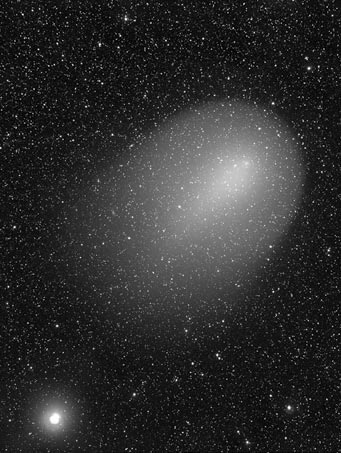
Comet Holmes, 1½° across, was already backing up toward Algol (lower left) when Dennis di Cicco took this shot on the evening of January 9th. He used a Tele Vue NP127is 5-inch refractor and an Apogee Alta U16M CCD camera. Click image for larger view.
S&T: Dennis di Cicco
Comets Holmes and Tuttle are far apart in the moonlit evening sky. Use binoculars to try for both. Holmes continues enlarging and dimming, so the moonlight will affect it particularly severely. Holmes crosses the 2nd-magnitude star Algol for several days centered on January 21st; see chart. (The dates on the chart are for 0:00 Universal Time, which falls on the evening of the previous date in the time zones of the Americas.)
Tuttle is much smaller than Holmes, more concentrated, and fading this week from about magnitude 6.0 to 6.5. It's now far south, crossing from southernmost Cetus into Fornax. See the article and chart in the January Sky & Telescope, page 73, or the brief version online. (Again, dates on the chart are for 0:00 UT.)
Tuttle a contact binary? Astronomers have used the Arecibo planetary radar to get an image of Comet Tuttle's solid nucleus with 300-meter resolution. J. K. Harmon and colleagues find that the nucleus "is a strongly bifurcated object, possibly a contact binary, with two roughly spherical lobes measuring 3 and 4 km in diameter (+/- 25 percent)," according to IAU Circular #8909. Also, "following the changing rotation aspect from night to night and within the 2.5-hour observing sessions gives a preliminary estimate of 7.7 +/- 0.2 hours for the rotation period."
---------------------------
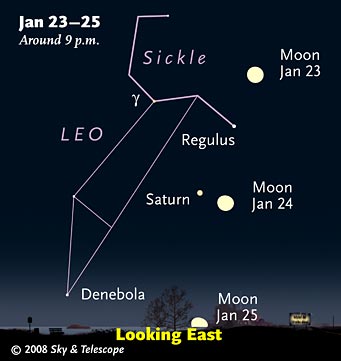
The bright Moon lights the way to Regulus and Saturn late on Wednesday and Thursday evenings.
Sky & Telescope diagram
Friday, January 18
- A small telescope will always show Titan, Saturn's largest moon. Tonight it's four ring-lengths to Saturn's east. A 6-inch telescope will begin to show the orange color of Titan's atmospheric smog. A guide to identifying all six of Saturn's satellites visible in amateur scopes is in the January Sky & Telescope, page 66.
Saturday, January 19
- Mars shines very close to the gibbous Moon early this evening for skywatchers in North America, and around the middle of the night as seen from Europe.
Sunday, January 20
- Mars shines well to the upper right of the Moon this evening. Pollux and Castor sparkle to the Moon's lower left.
Monday, January 21
- Mercury is at greatest elongation, 19° east of the Sun.
Tuesday, January 22
- Full Moon (exact at 8:35 a.m. EST, so the Moon will actually be just as full on Monday evening as Tuesday evening if you're in or near the Eastern time zone.)
Wednesday, January 23
- The bright Moon shines above Regulus and Saturn late this evening, as shown above. Watch it creep closer to Regulus during the course of the night.
Thursday, January 24
- Saturn and the waning Moon shine together tonight, as shown at right.
Friday, January 25
- Now that the early-evening sky is again moonless, be sure to check back on Comet Holmes, still close to Algol. Use binoculars or a good finderscope. And how many of the telescopic sights in its vicinity do you know about? See the article and map in Sue French's Deep-Sky Wonders column in the January Sky & Telescope, page 80.
Saturday, January 26
- It's still winter, but winter is getting pretty far along now — as you can see from the ascent of the Big Dipper. The Dipper is highest in late spring and early summer, but already it stands upright on its handle in the northeast as early as 8 or 9 p.m. (Winter's exact middle this year will be on February 4th at 12:58 p.m. Eastern Standard Time. The center of winter (approximately) is celebrated as Groundhog Day, also known as Candlemas or Imbolc.)
Want to become a better amateur astronomer? Learn your way around the constellations. They're the key to locating everything fainter and deeper to hunt with binoculars or a telescope. For an easy-to-use constellation guide covering the whole evening sky, use the big monthly foldout map in each issue of Sky & Telescope, the essential magazine of astronomy. Or download our free Getting Started in Astronomy booklet (which only has bimonthly maps).
Once you get a telescope, to put it to good use you'll need a detailed, large-scale sky atlas (set of maps; the standard is Sky Atlas 2000.0) and good deep-sky guidebooks (such as Sky Atlas 2000.0 Companion by Strong and Sinnott, the even more detailed Night Sky Observer's Guide by Kepple and Sanner, or the enchanting though increasingly dated Burnham's Celestial Handbook). Read how to use them effectively.
More beginners' tips: "How to Start Right in Astronomy".
This Week's Planet Roundup
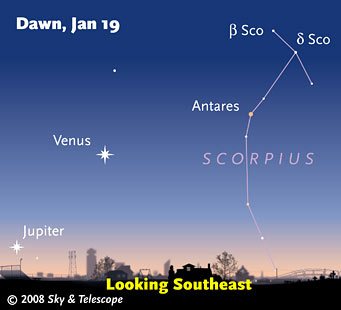
Venus, the bright Morning Star, attracts the eye at dawn. It's gradually settling lower this month, while Jupiter and Scorpius are sliding upward behind it, moving toward the upper right. Keep watch on their changing configuration each clear morning!
Sky & Telescope diagram
Mercury (magnitude –0.7) is having a fine evening apparition low in the western twilight. Look for it above the west-southwest horizon 45 to 60 minutes after sundown. Don't confuse it with dimmer, twinklier Fomalhaut far to the left in the southwest. The Messenger spacecraft flew by Mercury on January 14th, sending back our first close looks at the planet in nearly 33 years! See article.
Venus (magnitude –4.0, moving from Ophiuchus into Sagittarius) is the bright "Morning Star" low in the southeast before and during dawn, as shown at right. Look for much dimmer Antares sparkling orange-red off to its upper right, and Jupiter closing in on it day by day to its lower left.
Mars (about magnitude –1.0, in eastern Taurus) shines high in the east to southeast after dark. The blue-white star close above Mars is Beta (β) Tauri, also named El Nath. Mars is highest toward the south around 10 p.m., high over Orion — in fact passing near the zenith for observers at mid-northern latitudes.
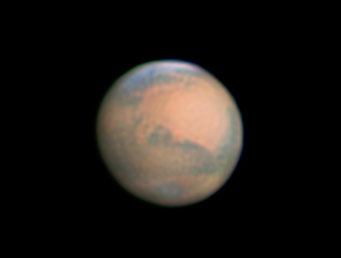
By the evening of Jan. 20th Mars was distinctly gibbous and down to 13.5″ wide, but it still showed good detail. The North Polar Hood of clouds (top) was diminishing. Sinus Meridiani and Sinus Sabaeus are the dark features running from just below center toward the right.
Click for an animation showing a full Martian rotation. Walker created the animation in WinJupos freeware, using 14 of his images taken between Oct. 5 and Dec. 31, 2007, with his 12.5-inch Newtonian telescope. For results like this, WinJupos can map your photos onto a Mercator projection, combine them to cover the complete planet if you have enough of them, then remap the Mercator projection onto a rotating globe. (The little moons zipping across were artificially added by the program.)
S&T: Sean Walker
Mars this week diminishes from 13.6 to 12.7 arcseconds in apparent diameter; it's falling farther behind us as Earth moves ahead of it in our faster orbit around the Sun. Mars is also turning gibbous again. See the telescopic observing guide and surface-feature map in the November Sky & Telescope, page 66, or the short version online.
Jupiter (magnitude –1.8, in Sagittarius) is low in the glow of dawn, lower left of brighter Venus, as shown above. Look for it about 45 minutes before sunrise. (To find your local sunrise time, make sure you've put your location and time zone into our online almanac.)
Once you've found Jupiter, watch it get higher and easier each morning as it closes in on Venus. On January 19th they're still 13° apart, but the gap between them is narrowing by 1° per day. These two brightest planets are heading toward a close conjunction (0.6° apart) on the morning of February 1st.
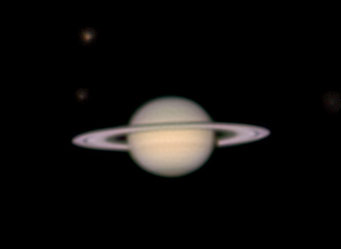
Titan and Rhea, Saturn's two brightest satellites, stood north of the planet when S&T's Sean Walker took this image at 6:17 UT Jan. 22, 2008.
S&T: Sean Walker
Saturn (magnitude +0.6, in Leo) rises in the east around 8 p.m. and is highest in the south in the early-morning hours. Fainter Regulus (magnitude +1.4) is 8° west of Saturn: to its upper right after they rise. Only a little dimmer than Regulus is Gamma (γ) Leonis, magnitude +2.1, 8° to Regulus's north. The three make an eye-catching triangle. Regulus and Gamma Leonis are the brightest stars in the Sickle of Leo (as shown in the "January 23" image above).
Uranus (magnitude 5.9, in Aquarius) is low in the southwest right after dark.
Neptune is hidden in the glow of twilight (near Mercury this week).
All descriptions that relate to your horizon or zenith — including the words up, down, right, and left — are written for the world's midnorthern latitudes. Descriptions that also depend on longitude (mainly Moon positions) are for North America. Eastern Standard Time (EST) equals Universal Time (UT, UTC, or GMT) minus 5 hours.
To be sure you always get the current Sky at a Glance, bookmark this URL:
http://SkyandTelescope.com/observing/ataglance?1=1
If pictures fail to load, refresh the page.
 0
0
Comments
You must be logged in to post a comment.